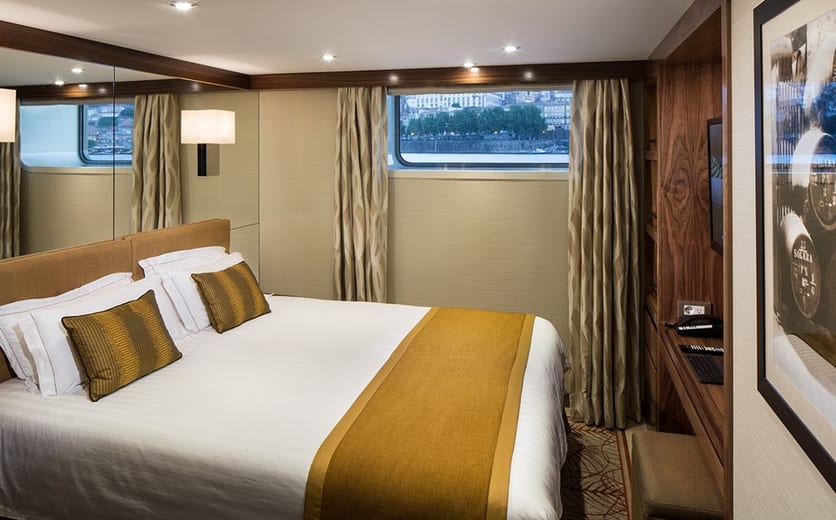




























































27 Dec - 03 Jan 2026
Return flights from the UK
7 Nights onboard AmaVida
Bikes*
Overseas Transfers*
Full Board Drinks (with meals)*
Complimentary Dining*
Speciality Dining*
Shore Excursions*
Entertainment*
Not Available
Sold Out
from
£4,211
per person
Sold Out
Our experts are here to help
Call us today on 0203 930 4640 or enquire online.





*Select voyages. T's and C's apply
Day 1
EMBARKATION – PORTO, PORTUGAL. Board the ship for your Enticing Douro cruise. (D)
Lively, commercial Oporto is the second largest city in Portugal after Lisbon. Also called Porto for short, the word easily brings to mind the city's most famous product - port wine. Oporto's strategic location on the north bank of the Douro River has accounted for the town's importance since ancient times. The Romans built a fort here where their trading route crossed the Douro, and the Moors brought their own culture to the area. Oporto profited from provisioning crusaders en route to the Holy Land and enjoyed the riches from Portuguese maritime discoveries during the 15th and 16th centuries. Later, port wine trade with Britain compensated for the loss of the spice trade and the end of gold and gem shipments from Brazil. In the 19th century, the city went through a period of new prosperity with the rise of industries. In its wake followed the building of workers' quarters and opulent residences. Since the declaration of Oporto as a World Heritage Site by UNESCO, the city aims to build up a cultural reference that will provide it with a new image, based on deep historical roots. Among the attractions that make Oporto such an interesting place are its graceful bridges spanning the Douro River, a picturesque riverfront quarter and, most notable, its world-famous port wine lodges. Although Oporto is a bustling centre and home to many different businesses, the source of its greatest fame is the rich, sweet fortified red wine we know as port.
Day 2
RÉGUA. This tranquil village offers an authentic slice of Douro River life. Today, visit the Baroque-style Palacio de Mateus and its gardens. Inside the house, you’ll see interesting furnishings, paintings and a ceiling of intricately carved wood. The gardens here are considered some of the most beautiful in Portugal. (B,L,D)
Day 3
VEGA DE TERRÓN, SPAIN. In the morning, spend time soaking up the beauty of this picturesque port before you visit Castelo Rodrigo, a small fortified village perched high on a hilltop with centuries-old walls, steep narrow streets and fantastic views. You can also opt to hike up to the village should you wish a more active exploration. (B,L,D)
Day 4
VEGA DE TERRÓN, SPAIN – SALAMANCA. Drive to Salamanca, a UNESCO World Heritage Site. Built of golden sandstone, Salamanca is known as a “living museum,” and you will have an opportunity to step back in time to the Middle Ages during your escorted tour, which includes the city’s elegant university buildings, the New Cathedral, the intriguingly decorated House of Shells and Plaza Mayor. (B,L,D)
Day 5
PINHÃO. Spend time soaking up the beauty of the Douro River as you cruise to Pinhão. Here, you may visit a local vineyard for a port wine tasting. Join a specialist from the vineyard on a private tour of the wine cellars, an exclusive opportunity to learn about centuries-old winemaking methods and to taste the vineyard’s specialty wines. Afterwards, be treated to an exclusive dinner at Quinta da Roêda. Nestled in the heart of the Douro Valley, this historic estate is celebrated for its centuries-old vineyards and iconic terraced landscapes. (B,L,D)
Day 6
RÉGUA. Travel to picturesque Lamego, home to one of the most important pilgrimage sites in all of Portugal, where you’ll go to the Nossa Senhora dos Remédios (Sanctuary of Our Lady of Remedies). The shrine features a staircase of nearly 700 steps, beautifully decorated with white and blue tiles, which the more active adventurer will want to climb on a guided hike. Concluding both tours, you will have the opportunity to sample local traditional specialties, such as bôlas de Lamego, bread filled with smoked ham; presunto, a type of dry-cured ham; and Espumante, a Portuguese sparkling wine. Afterwards, head to a local quinta for a delicious lunch. (B,L,D)
Day 7
PORTO. The colorful city of Porto blends the best of old and new, which you can discover on an escorted tour of the historic quarter, a UNESCO World Heritage Site, including the Cathedral, one of the city’s oldest monuments; and the São Bento Railway Station, known for its blue and white tile panels depicting scenes from Portuguese history. If you prefer to get more active, you can go on a guided hike. In the afternoon, you’ll also enjoy a tasting of Port, Portugal’s most renowned contribution to the world of wine. When the sun sets, enjoy the illuminated landscapes of Porto on a scenic cruise aboard your ship. (B,L,D)
Lively, commercial Oporto is the second largest city in Portugal after Lisbon. Also called Porto for short, the word easily brings to mind the city's most famous product - port wine. Oporto's strategic location on the north bank of the Douro River has accounted for the town's importance since ancient times. The Romans built a fort here where their trading route crossed the Douro, and the Moors brought their own culture to the area. Oporto profited from provisioning crusaders en route to the Holy Land and enjoyed the riches from Portuguese maritime discoveries during the 15th and 16th centuries. Later, port wine trade with Britain compensated for the loss of the spice trade and the end of gold and gem shipments from Brazil. In the 19th century, the city went through a period of new prosperity with the rise of industries. In its wake followed the building of workers' quarters and opulent residences. Since the declaration of Oporto as a World Heritage Site by UNESCO, the city aims to build up a cultural reference that will provide it with a new image, based on deep historical roots. Among the attractions that make Oporto such an interesting place are its graceful bridges spanning the Douro River, a picturesque riverfront quarter and, most notable, its world-famous port wine lodges. Although Oporto is a bustling centre and home to many different businesses, the source of its greatest fame is the rich, sweet fortified red wine we know as port.
Day 8
PORTO – DISEMBARKATION. Disembark the ship and prepare for your flight home. (B)
**DISCLAIMER: Itinerary subject to change.
Lively, commercial Oporto is the second largest city in Portugal after Lisbon. Also called Porto for short, the word easily brings to mind the city's most famous product - port wine. Oporto's strategic location on the north bank of the Douro River has accounted for the town's importance since ancient times. The Romans built a fort here where their trading route crossed the Douro, and the Moors brought their own culture to the area. Oporto profited from provisioning crusaders en route to the Holy Land and enjoyed the riches from Portuguese maritime discoveries during the 15th and 16th centuries. Later, port wine trade with Britain compensated for the loss of the spice trade and the end of gold and gem shipments from Brazil. In the 19th century, the city went through a period of new prosperity with the rise of industries. In its wake followed the building of workers' quarters and opulent residences. Since the declaration of Oporto as a World Heritage Site by UNESCO, the city aims to build up a cultural reference that will provide it with a new image, based on deep historical roots. Among the attractions that make Oporto such an interesting place are its graceful bridges spanning the Douro River, a picturesque riverfront quarter and, most notable, its world-famous port wine lodges. Although Oporto is a bustling centre and home to many different businesses, the source of its greatest fame is the rich, sweet fortified red wine we know as port.
from £0 per person

Stateroom Features

Stateroom Features
from £4,211 per person
from £0 per person
from £0 per person

Stateroom Features

Stateroom Features
from £4,211 per person
from £0 per person

















